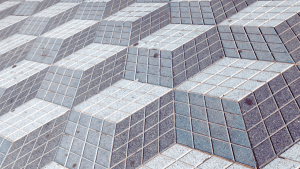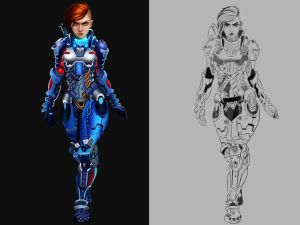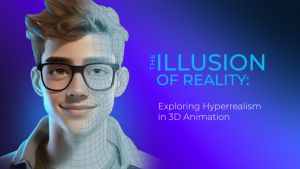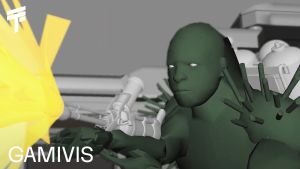What is Anamorphic Illusion?
Anamorphic illusion is an ancient art form that has recently resurfaced in the LED display and video content industry. It involves creating distorted projections that require viewers to occupy specific vantage points or use special devices to perceive recognizable images. In the context of motion graphics and VFX, anamorphic illusions allow us to watch video content on displays from certain angles, creating the illusion of a 3-dimensional environment.
Historical Roots of Anamorphic Techniques
Cave Paintings: The earliest documented use of anamorphic techniques dates back to cave paintings during the Stone Age. These paintings utilized the oblique angles of cave walls to create illusions.
Renaissance Art: During the Renaissance, artists like Leonardo da Vinci and Hans Holbein the Younger experimented with anamorphic illusions. Holbein’s famous painting “The Ambassadors” features a distorted grey slash that resolves into a human skull when viewed from a specific angle.
17th Century Revival: Anamorphic illusions resurfaced in the 17th century in Italy and China. For instance, the Church of St. Ignazio in Rome boasts a ceiling where Andrew Pazzo created the appearance of a dome on a flat surface.
World War I: Photographer Arthur Mole used anamorphic techniques during World War I to create patriotic images from massive groups of soldiers. When seen from a tower, these gatherings resolved into recognizable pictures.
Modern Applications of Anamorphic Illusions

Everyday Life
IMAX Theaters: IMAX screens often utilize anamorphic techniques to enhance the cinematic experience.
Road Signs: Ever noticed the words “Bus Lane” on the road? Anamorphic illusions make them legible from specific angles.
Street Art: Social media is filled with images of street art that play with anamorphic effects, causing viewers to do double takes.
Anamorphic Videos on Digital Displays
Advancements in LED display technology have opened up new possibilities for anamorphic illusions. Here’s how you can create your own anamorphic display videos:
Aspect Ratio: Start by shooting your footage in a standard aspect ratio (e.g., 16:9). Anamorphic lenses squeeze the image horizontally, so you’ll need to desqueeze it later.
Editing Software: Import your footage into video editing software (such as Adobe Premiere Pro or Final Cut Pro).
Desqueezing: Right-click on the clip in the timeline and select “Clip Attributes.” Under “Pixel Aspect Ratio,” set it to “1.3x Anamorphic” or “1.5x,” depending on your desired aspect ratio. This step ensures your footage displays correctly.
Chromatic Aberration: Add adjustable chromatic aberration to mimic the imperfections of anamorphic lenses. This effect enhances the illusion.
Bokeh Effects: Create oval-shaped bokeh effects to replicate the unique lens flares associated with anamorphic footage.
Color Grading: Apply color grading to achieve the cinematic look often seen in anamorphic films.
Remember, anamorphic illusions are all about perspective. Experiment, find your vantage point, and create captivating videos that leave viewers in awe. 
You can contact with null station for this services.
Types of Anamorphic Illusions
Anamorphic illusions come in a variety of forms, each with its own unique way of tricking the eye. Let’s know some of the most common types:
Cylindrical Anamorphs: Imagine a distorted image that only reveals its true form when viewed from the side of a cylinder. That’s the magic of cylindrical anamorphs. These illusions rely on the curved surface of the cylinder to correct the distortions in the artwork, making a recognizable image appear.
Mirror Anamorphs: Here, a strategically placed curved or cylindrical mirror becomes the key to unlocking the illusion. A seemingly random jumble of lines on a flat surface transforms into a coherent image when reflected in the mirror at a specific angle. The mathematics of reflection plays a crucial role in creating these mind-bending effects.
Multi-Perspective Anamorphs: Take a step back, then another, and watch the image change! Multi-perspective anamorphs are designed to be viewed from multiple vantage points, each revealing a different aspect of the hidden image. This type of illusion plays with the concept of perspective, forcing viewers to move around to grasp the complete picture.
Street Art Anamorphs: Step out onto the streets and prepare to be surprised! Street art anamorphs take the illusion outdoors, transforming sidewalks and walls into mind-bending experiences. These large-scale artworks often rely on specific viewing angles, like a designated spot on the street, to reveal their hidden image. They add a playful and interactive element to urban spaces.
These are just a few of the many ways anamorphic illusions can twist our perception. From cylindrical wonders to street art spectacles, each type offers a glimpse into the fascinating world of visual deception. Stay tuned as we explore the exciting world of creating your own anamorphic illusions!
FAQs
Q: What are some famous examples of anamorphic illusions?
A: There are many famous anamorphic artworks throughout history. The Ambassadors by Hans Holbein the Younger is a well-known example, where a skull only appears clear when viewed from a specific angle. Modern street art also features many anamorphic creations.
Q: Can I create my own anamorphic illusion?
A: Absolutely! There are software programs and online tools available to help you design your own anamorphic artwork. We’ll even provide a step-by-step guide in a future blog post!
Q: What are some real-world applications of anamorphic illusions?
A: Beyond their artistic value, anamorphic illusions have potential applications in architecture, design, and even education. For example, an anamorphic image could be used to create an optical illusion on a building facade, or to make educational materials more engaging.
Q: Are there any limitations to anamorphic illusions?
A: The main limitation of anamorphic illusions is the restricted viewing angle. The illusion only works from a specific perspective, which can be inconvenient for some viewers. Additionally, complex anamorphic designs can be quite challenging to create.
Q: What’s the future of anamorphic illusions?
A: The future of anamorphic illusions is bright! With the rise of augmented reality (AR), we can expect to see even more interactive and immersive anamorphic experiences. Additionally, anamorphic illusions could be used in new ways to improve communication and education.





